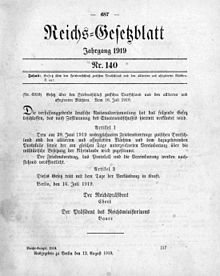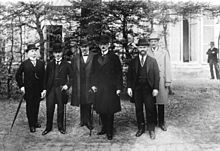Treaty of Versailles
![]()
Treaty of Versailles is a redirect to this article. For other meanings, see Treaty of Versailles (disambiguation).
The Peace Treaty of Versailles (also Treaty of Versailles, Peace of Versailles) was negotiated by the Allied and Associated Powers at the 1919 Paris Peace Conference at the Palace of Versailles by May 1919. The signing of the peace treaty ended the First World War on the level of international law. It was also the founding act of the League of Nations.
On 11 November 1918, the Compiègne Armistice had already ended the hostilities of the First World War, but not the state of war. The German delegation was not allowed to take part in the negotiations, but was only able to obtain a few amendments to the content of the treaty at the end through written submissions. The treaty stated that Germany and its allies were solely responsible for the outbreak of the world war and obliged them to cede territory, disarm and pay reparations to the victorious powers. After ultimate demand, Germany signed the treaty under protest in the Hall of Mirrors at Versailles on June 28, 1919. After ratification and the exchange of instruments, it entered into force on January 10, 1920. Because of its seemingly harsh terms and the manner in which it came about, the treaty was perceived by the majority of Germans as an illegitimate and humiliating dictate.
In addition to Germany, the signatories included the United States (USA), the United Kingdom, France, Italy, Japan, as well as Belgium, Bolivia, Brazil, Cuba, Ecuador, Greece, Guatemala, Haiti, Hejaz, Honduras, Liberia, Nicaragua, Panama, Peru, Poland, Portugal, Romania, the Kingdom of the Serbs, Croats and Slovenes, Siam, Czechoslovakia and Uruguay.
China, which had been at war with Germany since 1917, did not sign the treaty.
The United States Congress refused to ratify the Treaty of Versailles in 1920. The USA did not join the League of Nations and concluded a special peace with Germany in 1921, the Berlin Treaty.
Further Paris suburb treaties with the losers were the Treaty of Saint-Germain with German Austria on September 10, 1919, the Treaty of Neuilly-sur-Seine with Bulgaria on November 27, 1919, the Treaty of Trianon with Hungary on June 4, 1920, and the Treaty of Sèvres with the Ottoman Empire on August 10, 1920.

Play media file The Signing of the Peace Treaty of Versailles

William Orpen: The Signing of Peace in the Hall of Mirrors. Signing of the treaty in the Hall of Mirrors at the Palace of Versailles in 1919.

"Law on the Conclusion of Peace between Germany and the Allied and Associated Powers". Published in the German Reich Law Gazette of 12 August 1919 with the complete, trilingual treaty text.
Origin and ratification
The treaty was the result of the Paris Peace Conference of 1919, which met in the Palace of Versailles from 18 January 1919 to 21 January 1920. The location and opening date had not been chosen by chance: in 1871, German dignitaries had made the imperial proclamation in the Hall of Mirrors at Versailles during the siege of Paris. This (among many other factors, for example France's high reparations to Germany) reinforced Franco-German hereditary enmity and French revanchism ("Toujours y penser, jamais en parler"). France's head of government, Georges Clemenceau, hoped that the choice of location would heal a national trauma.
This had been preceded on 8 January 1918 by the 14-point programme of US President Woodrow Wilson, which from the German point of view was the basis for the Compiègne Armistice on 11 November 1918, which was initially limited to 36 days.
Beforehand, a select committee of Congress met, the so-called Council of Four, which included US President Woodrow Wilson, French Prime Minister Georges Clemenceau, British Prime Minister David Lloyd George and Italian Minister Vittorio Emanuele Orlando. The Council laid down the main points of the treaty. Only the victorious powers participated in the oral negotiations; only memoranda were exchanged with the German delegation. The result of the negotiations was finally presented to the German delegation as a draft treaty on 7 May 1919 - not coincidentally on the anniversary of the sinking of the RMS Lusitania. The German delegation - which included Professors Max Weber, Albrecht Mendelssohn Bartholdy, Walther Schücking and Hans Delbrück, as well as General Max Graf Montgelas - refused to sign and pressed for the provisions to be softened, although the German delegation was not admitted to the oral negotiations; notes were exchanged instead. Among the few subsequent improvements in the mantle note presented by the Allies on June 16 was the plebiscite in Upper Silesia. The victorious powers would not allow any further touch-ups and demanded the ultimate signature. Otherwise they would allow their troops to enter Germany. For this purpose the commander-in-chief of the Allied forces, Marshal Ferdinand Foch, had worked out a plan: From the already occupied Rhineland, the Entente troops were to advance eastward along the Main River to reach the Czech border by the shortest route, thus separating northern and southern Germany. In circles around the Chief President of East Prussia, Adolf von Batocki, the Social Democrat August Winnig and General Otto von Below, plans were developed to reject the peace terms outright and to abandon West Germany to the invading troops of the victorious powers without a fight. In the Prussian eastern provinces, where the Reichswehr was still relatively strong, an eastern state was then to be founded as a centre of resistance against the Entente. On June 20, 1919, Prime Minister Philipp Scheidemann resigned. Already on May 12, 1919, he had expressed his position in the Weimar National Assembly with the question that had become a common phrase:
"What hand would not wither that put itself and us in such bonds?"
Under pressure from the threat of invasion and the British naval blockade, which continued despite the armistice and led to fears of a dramatic worsening of the food situation, the National Assembly voted to accept the treaty on June 22, 1919, by 237 votes to 138. Scheidemann's party colleague and successor Gustav Bauer exclaimed in the session:
"We stand here out of a sense of duty, in the knowledge that it is our damned duty to try to save what can be saved [...]. If the Government [...] signs with reservation, it emphasizes that it is giving way to violence in the determination to spare the unspeakably suffering German people a new war, the rending of its national unity by further occupation of German territory, appalling famine for women and children, and merciless prolonged restraint of prisoners of war."
Foreign Minister Hermann Müller (SPD) and Transport Minister Johannes Bell (Centre) therefore signed the treaty - under protest - on 28 June 1919.
Although the representatives of the USA, the most important signatory power alongside Great Britain and France, were the first to sign the treaty after the two German delegates, the American Congress did not ratify the treaty. On November 19, 1919, and again on March 19, 1920, the treaty and the accession of the United States to the League of Nations were rejected. The USA therefore concluded the Berlin Treaty of 25 August 1921 with Germany.

The Accuser . Caricature of the American cartoonist Rollin Kirby from 1920: Mankind accuses the Senate of the United States for murdering the Treaty of Versailles.

American cartoon on the military threat against Germany: Because Wilson's 14-point plan is allegedly not being adhered to, Marshal Foch adds his saber point as the 15th point
Initial conditions
Two of the most important powers from the beginning of the war no longer existed:
- As a result of the October Revolution, made possible by the infiltration of Lenin by the German Reich, Soviet Russia had now emerged on the soil of the Russian Empire. The capitalist states now feared that the Soviet state, committed to world revolution, would threaten the domestic stability of all other states.
- The Austro-Hungarian Danube Monarchy had disintegrated at the Armistice.
Both warring parties had taken advantage of nationality problems in opposing states: the Central Powers had founded Regency Poland on the territory of the Tsarist Empire and had benevolently tolerated the founding of Lithuania. The Allies and the Slavic minorities of the Danube Monarchy had supported each other and were now beholden to each other.
Thus a general return to the pre-war borders was impossible and the reorganization was burdened with those problems that the drawing of borders between nation states inevitably entails.
By far the most severe war damage to civilian infrastructure was suffered by France and Belgium, which was invaded by Germany.

German peace negotiators before leaving for the Hotel Trianon. From left: Leinert, Melchior, Giesberts, Brockdorff-Rantzau, Landsberg, Schücking
Questions and Answers
Q: Who signed the Treaty of Versailles?
A: The nations of Japan, the United States, France, Germany and the United Kingdom all signed the Treaty of Versailles in 1919.
Q: Which countries were not involved in writing the treaty?
A: Germany, Austria and Hungary did not participate in writing the Treaty of Versailles.
Q: What military limitations was Germany required to accept?
A: Germany had to reduce its armed forces from 6 million to 100,000 men and had to get rid of its submarines and military aircraft as well as most of its artillery. It was allowed to keep only navy battleships.
Q: What territories did Germany have to give up?
A: Germany had to give back French territories that it had occupied as well as large territories to Poland and other neighbours and all of its colonies under the terms outlined in the treaty.
Q: What reparations were demanded from Germany by Allied countries?
A: As payment for damage done by German troops during World War I, huge reparations were demanded from Germany by Allied countries, particularly France; though an exact sum was not specified at first, many gold marks would be paid just as a part of what was owed by German debtors according to treaty stipulations.
Search within the encyclopedia